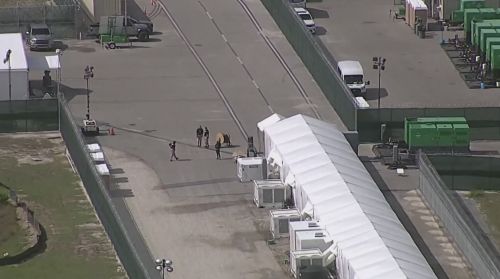

The path ahead, unless reversed, is not one of crisis management but of enduring institutionalization, a shift that may prove far harder to undo than to construct.

By Matthew A. McIntosh
Public Historian
Brewminate
From Florida Swamps to Nebraska Plains
The Trump administration’s turn toward large-scale immigrant detention began in Florida, where the notorious “Alligator Alcatraz” opened in the Everglades earlier in 2025. Built almost overnight, the site housed thousands in tents, trailers, and caged modules surrounded by swampland and National Guard patrols. The facility quickly drew lawsuits over sanitation failures, flooding, and restricted access to lawyers, earning comparisons to a “legal black hole.”
Despite widespread criticism, Alligator Alcatraz became a political showpiece, Trump himself touted it, saying, “It might be as good as the real Alcatraz site.” He called it a blueprint for further expansion. Merch, memes, and partisan chest-thumping turned a humanitarian crisis into a cultural spectacle.
It is against this backdrop that DHS unveiled its next project: the Cornhusker Clink in Nebraska.
A Prison Labor Camp Repurposed
Located in McCook, the Cornhusker Clink takes over the Work Ethic Camp, a minimum-security prison labor facility. Once home to fewer than 200 low-risk inmates, the camp is now being converted into a 280-bed ICE detention center, expandable to 300. Inmates were displaced, and the Nebraska National Guard has been tapped to supplement staffing.
Homeland Security Secretary Kristi Noem thanked Governor Jim Pillen, defending the move as a way to “remove the worst of the worst.” However, critics note that many detainees are not violent criminals, but asylum seekers or residents caught in immigration sweeps. The Nebraska Democratic Party (NDP) warned it would turn the state into a staging ground for federal overreach. NDP Chair Jane Kleeb wrote in a press release on August 19, 2025, “Creating fear and division is the Trump way, but does not have to be the Cornhusker way.” Focusing on the inhumane treatment of immigrants, the Party’s Communications Director, José Flores, Jr., wrote in the same release, “The majority of Nebraskans do not support a concentration camp anywhere in our state.”
A Model of Mass Detention
Together, Alligator Alcatraz and Cornhusker Clink exemplify the administration’s “One Big Beautiful Bill” initiative, which authorized up to $45 billion for 80,000 new detention beds by converting or constructing facilities across the country. Indiana’s “Speedway Slammer” and other projects are already on the horizon.
The strategy reveals a fusion of criminal justice and immigration enforcement: prisons and labor camps, once aimed at domestic offenders, are being retooled to house non-citizens. This repurposing blurs the lines between punishment and administrative detention.
The Spectacle and the Silence
Alligator Alcatraz showed how detention itself can become a cultural artifact. Social media jokes and memes overshadowed reports of worm-infested food and flooded toilets. Trump’s campaign embraced the imagery, leaning into the nickname as though detention were a tourist brand.
Cornhusker Clink does not yet carry the same cultural weight, but its very name suggests the same pattern. Detention is not only expanding but being normalized, even branded.
Legal and Civil Rights Backlash
Both facilities are already tied up in litigation. Civil liberties organizations warn that fast-track conversions skirt due-process protections and leave detainees in limbo. Environmental groups in Florida continue to press over swamp drainage and water contamination at Alligator Alcatraz, while Nebraska advocates argue the state prison system should not be entangled in federal immigration policy.
As Ruby Robinson of the Michigan Immigrant Rights Center put it, “A lot of this administration’s activities infringe on constitutional rights and do need to be resolved, ultimately, in courts.”
Looking Back
For Americans, the warning does not need to be sought abroad. History has already left its own testimony. During World War II, more than 120,000 Japanese Americans were forcibly relocated to internment camps under the logic of national security. The government insisted it was temporary, but the structures and stigma endured long after the war. Even earlier, Native peoples were displaced into reservations that combined confinement, surveillance, and forced labor under the guise of federal administration. Each moment shows how easily fear can give rise to carceral solutions and how long those solutions outlive the crises that birthed them.
And it was not only these communities who bore the weight of such policies. During the First World War, German Americans and other immigrants from “enemy nations” were rounded up and confined in camps across the Midwest, their loyalty questioned simply by ancestry. In the Red Scare years that followed, labor activists and immigrants from Eastern Europe were detained or deported for their political affiliations, often without due process. These precedents reveal a recurrent pattern: moments of perceived national peril produce expansive systems of confinement that reach well beyond their stated targets, entangling whole populations in webs of suspicion and control.
Looking Ahead
The landscape of detention in the United States is no longer defined by temporary holding centers along the southern border. With Alligator Alcatraz already operational in Florida and the Cornhusker Clink under construction in Nebraska, a template has been set. Each facility illustrates how the state apparatus can bend existing institutions (labor camps, prisons, even swaths of wetland) into instruments of immigration enforcement with startling speed. What began as exceptional responses to surges of arrivals is now morphing into a standing infrastructure of mass incarceration.
Florida’s Alligator Alcatraz has already demonstrated the scale of suffering and neglect that follows when speed and spectacle are prioritized over human rights. Sanitation breakdowns, legal blackouts, and militarized security created conditions that looked less like law enforcement and more like a cautionary tale. Yet the political theater surrounding the site has been embraced by its architects, suggesting that notoriety was part of the point. Nebraska’s Cornhusker Clink is different in scale but not in essence: the conversion of a modest work camp into an ICE detention hub signals that even the most local of correctional facilities can be folded into the federal deportation machine.
The trajectory points toward further replication. Indiana is already preparing the so-called “Speedway Slammer,” and other states with underused prisons are being scouted for similar conversions. If these projects continue at the current pace, the United States will have established not a series of emergency stopgaps, but a national archipelago of detention centers, each linked by the same logic of mass exclusion. What was once debated as a temporary necessity is settling into permanence.
Conclusion
This American turn toward normalized mass detention does not exist in isolation. Across the world, similar logics are taking root. Australia pioneered offshore detention by relocating asylum seekers to Nauru and Manus Island, facilities notorious for their remoteness and harsh conditions. The European Union, too, has developed “hotspot” camps in Greece and Italy where migrants are held in overcrowded, indefinite conditions as part of a deterrence strategy. Even the United Kingdom has pursued agreements to offshore asylum processing to Rwanda, a move critics argue erodes human rights while projecting toughness.
Each of these examples mirrors the underlying rationale now evident in the U.S.: deterrence by spectacle, control through confinement, and normalization of detention as a permanent feature of migration policy. The echoes are sobering. Nations that pride themselves on democratic values are converging on a model that treats mobility less as a human right than as a threat to be contained in camps and compounds.
The deeper question is what this normalization does to democratic society. When detention becomes both policy and spectacle, when prison labor camps and swamp compounds are rebranded with nicknames that invite memes and merchandising, the country risks eroding the very distinction between justice and punishment, between immigration administration and carceral ideology. The path ahead, unless reversed, is not one of crisis management but of enduring institutionalization, a shift that may prove far harder to undo than to construct.
Originally published by Brewminate, 08.25.2025, under the terms of a Creative Commons Attribution-NonCommercial-NoDerivatives 4.0 International license.


